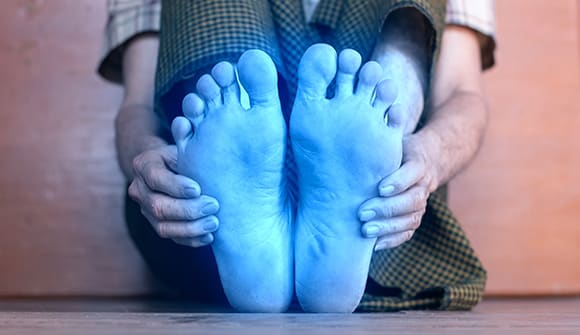The PVD three
Don’t ignore these signs of peripheral vascular disease.
Article Author: Juliette Allen
Article Date:

Cold feet are nothing a pair of fuzzy socks can’t cure, right? If it’s occasional, it may not be a critical concern, but a continual chill may be sign of peripheral vascular disease (PVD).
Who gets PVD?
Peripheral vascular disease – an umbrella term for diseases of the veins and arteries, including peripheral arterial disease (PAD) – is caused by the narrowing or blocking of the blood vessels, often due to buildup of plaque.
According to the National Institutes of Health, around one in 20 American adults over the age of 50 has PVD. Risk factors include heart disease, diabetes, high blood pressure, being overweight and smoking.
Notice these three? Could be PVD.
According to vascular interventional cardiologist Raghav Gupta, MD, medical director of the Peripheral Vascular Program at Baptist Heart Specialists, symptoms of PVD stem from lack of blood flow to the muscles and skin of the legs and arms. Because blood can’t reach these areas, it’s unable to deliver oxygen, without which the muscles and skin can start to show signs of damage.
The reduced blood flow can lead to:
- Cold feet or legs.
- Heaviness of feet or legs when walking or climbing stairs.
- Hair loss or reduced nail growth in the affected area.
“If you notice any of these signs, you should contact your primary care doctor or cardiologist immediately,” said Dr. Gupta. “When left untreated, PVD can lead to ulcers that can sometimes cause skin and muscle tissue to die. This complication is called critical limb ischemia [CLI], and it affects around 10% of patients with leg pain and PAD.”
Serious cases of CLI can lead to amputation and, in some cases, be life threatening.
Reopening the flow
According to Dr. Gupta, treatment for PVD depends on each individual case, but options include:
Lifestyle changes. Mainly, quitting smoking and incorporating exercise. A regular walking or jogging routine can make a big difference!
Medication. Blood thinners like aspirin can prevent additional narrowing or blockages, as can drugs to treat high blood pressure and cholesterol.
Procedures. When the blockage is severe, minimally invasive therapies such as balloons or stents, or in certain cases surgery, may be required to treat the blood vessel and restore blood flow.
“It’s easy to dismiss some of these symptoms as something trivial, but it’s important for people to be aware of PVD so they can talk to their doctor about it,” said Dr. Gupta. “The sooner we’re able to make a diagnosis and start an appropriate treatment plan, the better the outcome.”
If you’re experiencing symptoms that could be peripheral vascular disease, contact your primary care physician for an evaluation and to discuss whether a referral to a cardiologist is needed. To find the right provider for you, call 904.202.4YOU (4968) or fill out the appointment request form.
Source: National Institutes of Health



